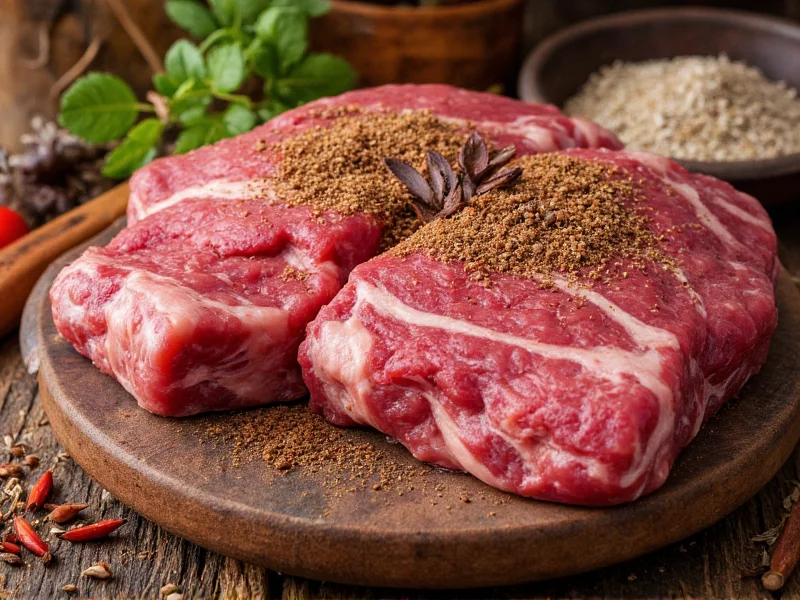Understanding which spices work best with beef transforms ordinary dishes into extraordinary culinary experiences. Beef's rich, meaty flavor provides an ideal canvas for both bold and subtle seasonings. The right spice combination can elevate your steak, roast, or ground beef dish from simple to spectacular.
Why These Spices Complement Beef
Beef contains high levels of glutamates that create that satisfying umami taste. The best spices for beef work synergistically with these compounds. Scientifically, certain compounds in spices like eugenol (in cloves) and thymol (in thyme) interact with meat proteins during cooking, creating new flavor compounds through the Maillard reaction. This chemical process develops complex flavors that simple salt and pepper alone cannot achieve.
Essential Spices for Beef: A Comprehensive Guide
While personal preference plays a role, certain spices have stood the test of time for good reason. Here's a detailed breakdown of the most effective spices for different beef preparations:
| Spice | Flavor Profile | Best For | Usage Tip |
|---|---|---|---|
| Black Pepper | Sharp, pungent, slightly floral | All beef cuts, especially steaks | Add after cooking to preserve volatile oils |
| Rosemary | Pine-like, woody, slightly citrusy | Ribeye, prime rib, roasts | Use fresh sprigs for roasts; chop finely for steaks |
| Garlic | Pungent, savory, sweet when cooked | Ground beef, stews, braises | Add minced garlic during last 2 minutes of cooking |
| Smoked Paprika | Earthy, smoky, mildly sweet | Brisket, chuck roast, burgers | Combine with cumin for authentic barbecue flavor |
| Mustard Powder | Sharp, tangy, slightly bitter | Rubs for roasts, steaks | Mix with oil to activate enzymes before applying |
Regional Spice Traditions for Beef
Different culinary traditions have developed unique spice combinations that work exceptionally well with beef. Exploring these regional approaches gives you a broader palette of flavors:
- French Technique: Herbes de Provence (thyme, rosemary, oregano, marjoram) with shallots and red wine reduction creates classic steak au poivre
- Argentinian Approach: Chimichurri (parsley, oregano, garlic, red pepper flakes, vinegar) provides bright contrast to grilled meats
- Asian Fusion: Five-spice powder (star anise, cloves, Chinese cinnamon, Sichuan pepper, fennel seeds) works surprisingly well with short ribs
- Middle Eastern Method: Baharat (black pepper, cumin, coriander, cinnamon, cardamom) creates complex flavor in ground beef dishes
Matching Spices to Beef Cuts
Not all beef cuts respond equally to the same spices. Understanding which seasonings work best with specific cuts ensures optimal flavor development:
For Steaks (Ribeye, Strip, Filet)
High-quality steaks benefit from simple seasoning that enhances rather than masks their natural flavor. The classic combination of coarse salt and freshly cracked black pepper remains unbeatable. For more complexity, add a small amount of garlic powder and smoked paprika to your salt mixture. Apply 45 minutes before cooking to allow the salt to penetrate the meat.
For Roasts (Chuck, Brisket, Round)
Longer cooking times allow for more complex spice blends. Create a dry rub with equal parts smoked paprika, garlic powder, onion powder, and brown sugar, plus half parts each of cumin, mustard powder, and black pepper. Massage this mixture into the meat 12-24 hours before cooking to allow flavors to penetrate deeply.
For Ground Beef (Burgers, Meatloaf, Tacos)
Ground beef readily absorbs flavors, making it ideal for bolder spice combinations. Try mixing Worcestershire sauce, garlic powder, onion powder, smoked paprika, and a pinch of cayenne into your meat. For burgers, avoid overmixing which can make the patty tough. Add spices just until incorporated.
Advanced Spice Techniques for Beef
Professional chefs use several techniques to maximize spice impact when cooking beef:
Dry Brining with Spices
Combine your spice mixture with coarse salt (3:1 ratio of salt to spices) and apply generously to the meat. Refrigerate uncovered for 1-3 days. This technique seasons the meat throughout while improving texture and moisture retention.
Layering Spice Applications
Apply different spices at different cooking stages. For example, rub rosemary and thyme on before searing, then finish with freshly cracked black pepper and a sprinkle of flaky sea salt after cooking. This creates complex flavor dimensions rather than a single-note seasoning.
Spice Oil Infusions
Create custom oil blends by gently heating neutral oil with your chosen spices for 10-15 minutes. Strain and use to baste meats during cooking or drizzle over finished dishes. This technique extracts delicate flavor compounds that might burn if applied directly.
Common Spice Mistakes to Avoid
Even experienced cooks make these common errors when seasoning beef:
- Adding salt too late: Salt needs time to penetrate meat. Apply at least 45 minutes before cooking for best results
- Using pre-ground spices: Freshly ground spices have significantly more volatile flavor compounds
- Overpowering the meat: Beef should remain the star; spices should complement, not dominate
- Burning spices: Many spices burn at lower temperatures than ideal searing heat; add delicate spices later in cooking
Creating Your Own Signature Beef Spice Blend
Once you understand basic principles, experiment with creating personalized blends. Start with this formula:
- Base (60%): Coarse salt and black pepper
- Primary Flavor (30%): Choose 1-2 dominant spices (rosemary, smoked paprika, garlic)
- Accent (10%): One surprising element (cocoa powder, coffee, citrus zest)
For example, a coffee-ancho chili blend works exceptionally well with ribeye steaks, while a combination of smoked paprika, cumin, and a touch of cinnamon elevates ground beef tacos.











 浙公网安备
33010002000092号
浙公网安备
33010002000092号 浙B2-20120091-4
浙B2-20120091-4